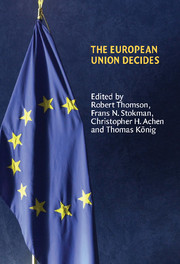Book contents
- Frontmatter
- Contents
- List of figures
- List of tables
- Notes on contributors
- Preface
- 1 Explaining legislative decision-making in the European Union
- 2 Research design: measuring actors' positions, saliences and capabilities
- 3 Testing procedural models of EU legislative decision-making
- 4 Institutional realism and bargaining models
- 5 Compromise, exchange and challenge in the European Union
- 6 Nash versus Schelling? The importance of constraints in legislative bargaining
- 7 A cooperative approach to decision-making in the European Union
- 8 A procedural exchange model of EU legislative politics
- 9 Beyond informal compromise: testing conditional formal procedures of EU decision-making
- 10 Evaluating political decision-making models
- 11 Evidence with insight: what models contribute to EU research
- Appendix I Selection of Commission proposals
- Appendix II Comparison of expert judgements with each other and with information from Council documentation
- References
- Index
- Title in this series
11 - Evidence with insight: what models contribute to EU research
Published online by Cambridge University Press: 22 September 2009
- Frontmatter
- Contents
- List of figures
- List of tables
- Notes on contributors
- Preface
- 1 Explaining legislative decision-making in the European Union
- 2 Research design: measuring actors' positions, saliences and capabilities
- 3 Testing procedural models of EU legislative decision-making
- 4 Institutional realism and bargaining models
- 5 Compromise, exchange and challenge in the European Union
- 6 Nash versus Schelling? The importance of constraints in legislative bargaining
- 7 A cooperative approach to decision-making in the European Union
- 8 A procedural exchange model of EU legislative politics
- 9 Beyond informal compromise: testing conditional formal procedures of EU decision-making
- 10 Evaluating political decision-making models
- 11 Evidence with insight: what models contribute to EU research
- Appendix I Selection of Commission proposals
- Appendix II Comparison of expert judgements with each other and with information from Council documentation
- References
- Index
- Title in this series
Summary
INTRODUCTION
The Treaties of Maastrict, Amsterdam, and Nice are milestones of European integration. In each case, the negotiation and ratification processes attracted widespread media and popular attention. More recently, the Treaty Establishing a Constitution for Europe also drew sustained interest from broad sectors of European society until it failed ratification in several member states during 2005. Academics are drawn to stirring events just as the press and public are, and thus many political scientists have written engagingly about the ‘grand bargains’ embodied in the successive EU treaties (e.g. Moravcsik 1998).
Day to day, however, the business of the EU does not make front-page headlines. Like any government, the EU spends most of its time deciding routine matters, such as the wording of health warnings on tobacco products or the funding of student exchanges in Europe. Indeed, both tobacco label and student exchange decisions appear in the data set used in this book. The EU's own organs decide these issues—the Commission, the Council of Ministers, and the European Parliament (EP). Mid-level civil servants and ordinary Members of the European Parliament (MEPs) may play critical roles. Prime ministers and chancellors, who loom so large in the grand bargains, do not.
In this volume, we have directed our energies toward the explanation of everyday EU decisions. We make no apology for doing so. Although some legislative acts are merely technical correctives or minor bureaucratic rule-making, the great majority of the decisions examined here affect the lives of many Europeans.
- Type
- Chapter
- Information
- The European Union Decides , pp. 299 - 316Publisher: Cambridge University PressPrint publication year: 2006
- 23
- Cited by

